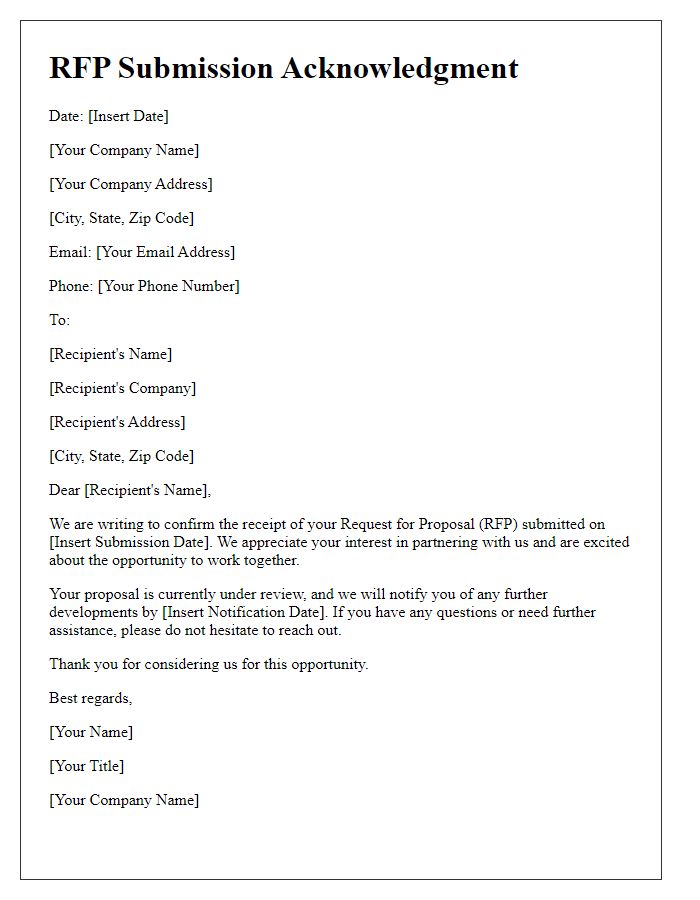Are you looking to craft the perfect response to a request for proposal (RFP)? Writing a compelling letter can make all the difference in showcasing your expertise and winning that project. It's essential to clearly outline how your organization meets the requirements while conveying your enthusiasm for the opportunity. Dive in to discover key strategies and tips that will help you create an impactful RFP response letter!

Clear Subject Line
A clear subject line, such as "Request for Proposal Response - [Your Company Name]" ensures immediate understanding of the email's purpose. A well-structured subject line enhances visibility in crowded inboxes, particularly for recipients like project managers or procurement officers. Including a specific project name or proposal reference number, like "RFP 2023-045" or "Web Development Services Proposal" can aid in efficient tracking and organization of communications. This attention to detail signals professionalism, essential in competitive bidding scenarios across various industries, including technology and construction.
Professional Greeting
A request for proposal (RFP) response often begins with a professional greeting that establishes a respectful tone for the correspondence. For example, addressing the recipient by their title and last name, such as "Dear Mr. Smith" or "Dear Ms. Johnson," indicates a formal and respectful approach. Additionally, including the name of the organization, such as "Dear Mr. Smith, ABC Corporation," adds specificity and relevance to the greeting. The opening line can express appreciation for the opportunity to submit a proposal, such as, "I appreciate the opportunity to present our proposal in response to your RFP for the XYZ Project." This sets a positive tone and acknowledges the recipient's efforts in considering multiple proposals.
Introduction and Purpose
The Request for Proposal (RFP) response serves as a formal answer to a solicitation issued by a government agency or a private organization seeking vendors for a specific project or service. The primary purpose of the RFP response is to articulate how the proposing entity, such as a construction firm, software developer, or consulting agency, meets the criteria outlined in the RFP. Key components include an overview of the company's qualifications, project understanding, proposed methodology, and adherence to the RFP's requirements. Specific attention is given to budget estimates, timelines, and deliverables to ensure alignment with the organization's objectives, such as improving efficiency or cost management within specified parameters. This structured document is essential for fostering transparent communication between the proposer and the requesting entity, ultimately facilitating informed decision-making.
Detailed Proposal Response
A detailed proposal response outlines a comprehensive plan addressing the requirements specified in the Request for Proposal (RFP) document. The response should begin with an executive summary that highlights key aspects such as project objectives, anticipated outcomes, and unique selling points. It must include a project timeline, detailing each phase with start and end dates, ensuring adherence to deadlines outlined in the RFP. Budget breakdowns should include specific figures, allocating funds for resources, labor, and contingencies. The qualifications section should feature relevant experience, showcasing case studies or success stories from prior projects, preferably within the same industry or similar scope. It is essential to provide detailed methodologies outlining processes and strategies that will be employed to meet the project goals. Additionally, risk management strategies must identify potential challenges and mitigation plans, ensuring stakeholder confidence in the project's success. Lastly, appendices may contain necessary documentation, such as certifications, references, and legal compliance information, to reinforce the proposal's credibility.
Contact Information for Follow-Up
In project management, contact information serves as a vital link between proposing organizations and clients during the response phase of a request for proposal (RFP). Clear identification of key contacts, including names, positions, phone numbers, and email addresses, ensures seamless communication regarding project details or clarification requests. For example, stakeholders may need to discuss terms outlined in an RFP dated September 2023, requiring immediate access to specific project managers or legal representatives. Accurate and updated contact information fosters trust and facilitates quicker decision-making, enhancing the overall proposal experience for both parties involved.













Comments